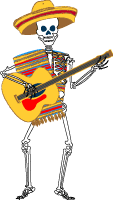 History
History November first begins the Dia de los Muertos (also known as "Day of the Dead") festivities with All Saints Day in which the deceased children are honored and remembered. November second All Souls Day is for the remembrance of the adult dead. Dia de los Muertos combines these days to celebrate the the deceased and enjoy their memories. Dia de los Muertos is not at all scary, spooky or somber. The spirits of the deceased are thought to pay a visit to their families during Dia de los Muertos and the families prepare an altar for them.
 The Altar
The Altar
Before Dia de los Muertos, an area of the house is cleaned up and the furniture removed to make room for the altar. The altar consists at a minimum of a covered table, and usually a few crates or boxes are added to it and covered to create open shelves and other raised display areas. The coverings used can vary from plain to vibrantly colored oil cloth. The altar is then set up with the appropriate ofrendas (offerings) for Dia de los Muertos.
Ofrendas (Offerings)
The offerings placed on the altar for Dia de los Muertos usually consist of a wash bowl, basin, razors, soap and other items the traveling spirit can use to clean-up after the journey. Pictures of the deceased are also placed on the altar as well as personal belongings for each person and any other offerings the deceased may enjoy such as a pack of cigarettes or a bottle of tequila. Candles are used to help light the way for the spirits as well as other decorative items such as papel picado (tissue paper cut-outs) wreaths, crosses and flowers. Certain Dia de los Muertos dishes are also placed on the altar to help feed and nourish the traveling souls. Some of these offerings also double as the four main elements of nature — earth, wind, water, and fire. These are represented by movable or light-weight items such as tissue paper cut-outs (wind,) a bowl of water, candles (fire) and food (crops, earth.)
"Day of the Dead" Recipes
- Sugar Skulls
The most popular "Dia de los Muertos" ofrenda is Sugar Skulls. Sugar skulls are a traditional folk art from Central and Southern Mexico used to celebrate Day of the Dead. Mounds of colorful sugar skulls are sold by vendors in the village open air markets during the week preceding Day of the Dead. Increasing numbers of non-traditional colorful candies such as decorated chocolate skulls and other Halloween candies are now competing with the traditional sugar skulls, which are becoming harder and harder to find in Southern Mexico. The skulls are made of a sugar mixture that has been pressed into molds and then dried. The dried sugar skulls are decorated with icing and sometimes non-edible items such as colored foil, feathers or sequins. View some finished sugar skulls in the Sugar Skulls Gallery. - Pan de Muerto
This sugary, sweet bread is enjoyed by the families of the deceased during Dia de los Muertos, as well as placed on the altar. The Pan de Muerto is a made into a loaf and and extra dough is fashioned into decorations resembling bones. The bread is baked, glazed and decorated with colored sugar. - Candied Pumpkin
This sweet dish consists of fresh pumpkin slices that are cooked in a piloncillo glaze. The Candied Pumpkin is also enjoyed by the family during Dia de los Muertos as well as placed on the altar. - Chocolate Coffins and Skulls
These chocolate items are a newer addition to the altars. They can be plain or decorated with other edible items such as colored sugar, brightly colored candies or sprinkles. Chocolate Coffins and Skulls can be bought pre-made or you can make them yourself. - Atole
A hot cup of masa gruel known as Atole is used to nourish and warm the spirits when they return and/or when they leave.
Other Festivities
Mexican families also make a trip to the cemetaries during Dia de los Muertos to clean up the family members gravesites and decorate them as well. Many carts and and vendors are set up around the cemetaries to sell decorations and flowers for the gravesites. Local bands go around and play music for the deceased and the families. The larger cities often have parades with horses, dancers and musicians. The vendors take advantage of the large crowds during Dia de los Muertos and sell sugar skulls, candy coffins, and other "Day of the Dead" treats.

No comments:
Post a Comment